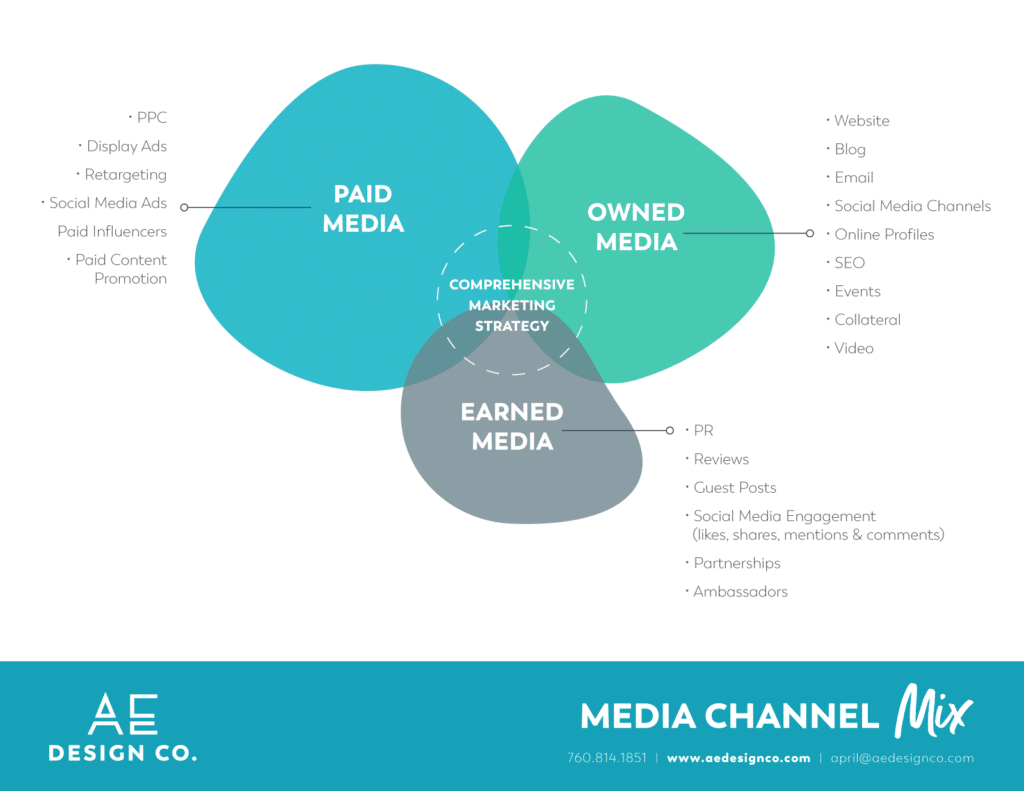Do you want to get more juice out of the squeeze and increase blog traffic with all the effort you put into writing blog articles? If so, you need a content distribution plan.
It would be great if writing a great blog post and hitting publish were enough to get prospects knocking on your door. Unfortunately, this is not the ticket to success if you’re wondering how to get traffic to your blog.
I can’t even count the number of small businesses I’ve seen with this presumption, but it’s far from the truth.
The movie “Field of Dreams” gave us the quote, “If you build it, [they] will come.” It’s a wonderful quote, but driving traffic to your website and blog requires more effort than merely publishing a piece.
To get results from content marketing, making great content is just a small (but necessary) part of the equation.
You also need to intelligently promote it across various channels to ensure it appears in front of your audience. Because people have so many ways to consume information (think radio, TV, cable, streaming, web, social media, direct mail, and more), you need to be on several channels.
Welcome to content distribution.
In fact, blog promotion and distribution are the most critical parts.
Failing in these aspects of the process could result in blog posts with considerably lower visibility – even if they’re A-M-A-Z-I-N-G.
Even if you optimized a blog article to attract searchers on Google (SEO) – and I sure hope it is – it will take time to work its way up through the search rankings to get eyes on your content.
If you haven’t thoughtfully and intentionally distributed your content up until this point, I HATE to be the one to tell you this, but you’ve been missing out big time.
It only takes a few extra steps to reap the rewards of strategic content distribution.
How does content distribution work?
Content distribution consists of promoting your blog post or sharing your content through various online channels – such as posting on social media, creating paid ad campaigns, and publishing on third-party sites. This lets your content appear in front of your audience by meeting people where they actually spend time.
A simple example of distributing content is sharing your new blog posts on your social media accounts, like Facebook, Twitter, or LinkedIn.
But this is just the tip of the iceberg when it comes to effective content promotion channels. There are so many options to distribute the content you create:
The media channel mix
Paid channels
- PPC channels
- Google Ads
- Social media ads (e.g., Facebook ads)
- (Paid) Influencers
Earned channels:
- Reviews
- Guest posts
- Reposts or shares on social media
- Organic traffic
Owned channels:
- Website
- Social media
- Blog
Don’t get overwhelmed by the options
With so many channels and options, content distribution can seem overwhelming and time-consuming.
But there’s something even more time-consuming:
Investing a ton of time in writing a piece of content that no one even reads.
Why???
Here’s the thing. You spend a bunch of time building a content strategy and making sure you publish high-quality content that’s valuable!
Even though content distribution means spending more time on each blog post, it helps you make sure it doesn’t go unnoticed by your audience.
The last thing you want is having your efforts go to waste because you took the “stealth submarine” approach and stayed under the radar.
You’ll end up wasting a lot of time if you don’t take the extra step to promote your amazing content. I mean, you want people to read it, right? You wrote it to provide relevant information and answers to your readers and those searching for a solution you can provide.
The odds are that your target customers won’t visit your blog on their own accord every time you publish a new post.
They’re more likely to be around on social media, their Gmail inbox, or Google search – but most likely not on your blog page! Good blog promotion helps you squeeze the last drop of juice out of each post by appearing in the places where your audience invests their time.
Here’s what to expect when you hop on the content distribution train.
- Higher ROI from your blog
- Continually engage and nurture your readership
- Achieve more remarkable results from the time you spend
- Prevent the dreaded “no-results-at-all posts”
Proven and effective blog promotion strategies for content distribution
When considering alternatives to distribute your blog content, Google Search should be at the very top of your list.
Google, as a tool, has nearly become an extension of ourselves and an integral part of content distribution.
Remember how witches used to gaze deeply into a “crystal ball” to find answers to their questions?
Google is as useful as that crystal ball, and it’s accessible to EVERYONE. It’s not a surprise that most people resort to this revolutionary tool to find answers to their problems.
There are two ways you can reach Google users and steer them to your blog content:
#1: SEO (Search Engine Optimization)
SEO consists of optimizing your content to show up in the organic search results when people type specific queries (which consultants refer to as keywords).
To put it simply, SEO involves tweaking your content to convince Google that your content is useful for searchers.
One of the factors that Google measures are the keywords contained in your content. Through these keywords (and many other factors), Google determines where your posts should appear among the search engine results pages (SERPs).
If there’s a blog promotion tactic you need to be doing, it’s SEO (and also content sharing on social media).
Related: Reasons Why Your Business Should Invest in SEO
#2: PPC (pay-per-click)
PPC consists of paying a fee to rank your pages on any search query of your choice. And you can rank your content almost immediately.
But unlike SEO content, you need to pay every time a user visits your pages and posts.
Related: Here’s a comparison between PPC and SEO.
Promoting your blog posts via PPC like Facebook ads is a fast way to get your content in front of interested people because you target a specific audience.
TIP: You can serve up retargeting ads to people who have read your article from a Facebook ad to promote your offers like a free consultation or an ebook. Talk about a great content distribution strategy!
Google Ads (PPC) or SEO? Which will grow my small business?
Email marketing is still one of the most effective channels to engage your audience consistently.
This tool allows you a better way to connect with customers, nurture prospects, and promote your blog content.
Many people check their inboxes throughout the day, and email marketing lets you notify subscribers regularly. These characteristics make it highly likely your raving fans will receive the latest news.
There are many approaches to distribute your blog content with this channel.
Some brands include entire posts from their blog in their emails.
Others share just a short description with a link to the article’s page.
You can also repurpose your blog post by creating a summarized version – if your subscribers prefer short, snackable snippets.
Even better, you can set up one template that automatically sends an email every time you publish a new article on your blog. (We love this method because we have a passion for making processes easy and less time-consuming.)
Social Media
Tweeting or posting your new articles on social media gives them additional exposure to your audience. This needs to be part of your content distribution plan.
Considering how popular social networks are nowadays, skipping this medium doesn’t make any sense (like, at all).
A good rule of thumb is to use at least 3 social platforms. Your industry will dictate where you need to be to reach your target audience.
Also, put a lot of thought into your social media content strategy! And, make sure you have a content creation plan for the days ahead.
As you implement your plan for content creation and distribution, make sure you share your content more than once and in different ways.
Maybe the first time you share the link to your post and subsequent social media posts will highlight snippets from your content. The key is to be consistent and post multiple times to social media.
Infographics
Writing a blog post isn’t an easy task.
Writing a great blog post … that’s on a whole ’nother level.
Repurposing a blog post into an infographic helps you squeeze out more results from your hard work in a nice visual that many easily understand.
Compared to making an infographic from scratch, repurposing lets you skip researching as the ideas have already been laid out.
You can share repurposed infographics on social media, your email newsletter, or other channels – always linking to the original blog post.
Infographics are the fourth most used type of content marketing. It’s a very successful format because the human brain loves visuals and images.
Remember, all of these tactics are about reaching people in ways they prefer and where they spend their time online.
Infographics can show up on Google in an image search. Plus, you can post your infographic on social media as a separate post.
And, after you create an infographic, add it to your blog post. When readers see it, they will be curious about it and end up spending more time on your website, which is a good thing.
Need help making an infographic? Check out Visme infographic design software for non-designers.
Content Syndication / Article Submission Websites
Content syndication is when a blog article is re-published on a different website, directory, or forum to reach a broader audience.
Bonus: Distributing your articles on other relevant, high-authority websites will also help you build backlinks and drive more traffic to your website (I’ll explain backlinks in the next section).
This is gold (and an added benefit)!
You see, links on other high-authority websites that point to your content improve your overall SEO, too! Google views backlinks as signs that your website contains high-quality content. And, it rewards your website with higher search rankings that = more traffic to your site.
With that said, we recommend not copying and pasting your entire article on blog submission websites because Google may penalize you, which is not good for your content distribution efforts.
LinkedIn articles are a great example. You can still get the meat and potatoes repurposed in articles posted on LinkedIn, and you can create a permanent piece of content on your professional profile.
See how we repurpose articles for LinkedIn:
You want people to go back to your website, so only give them enough to whet their appetite so they will want to read the full article on your blog. Remember, each article submission website is different.
Link Building Outreach
Submission sites are a great way to get backlinks – and so is good, old-fashion link outreach.
Link outreach consists of contacting people in your industry to earn backlinks, pointing to your content. It’s a very useful article marketing practice … if you get it right.
You should reach out to websites whose readers are likely to find value in your content.
These can be other businesses, association websites, and influencers.
Just a reminder! This only works with high-quality content that’s worth linking to :).
When reaching out to these websites, personalize your email messages, and build relationships to encourage them to link to your articles.
Backlinks are still one of the most crucial SEO ranking factors to this day. Although acquiring them can be challenging, the rise in rankings – and the extra traffic to your site – make it worth the effort.
Turn your content into a video
Creating a video with a comprehensive, summarized guide of your content means half of the work has been done already.
Researching, jotting down all the ideas on paper, and cohesively putting everything together are often the most time-consuming aspects of producing videos.
But your blog posts make video creation easier.
To squeeze the juicy juice out of your videos, try to promote them in multiple distribution channels – such as YouTube, Facebook, Twitter, and Instagram stories.
And, ideally, edit videos for length, resolution, and aspect ratio for each platform.
Turn blog content into a podcast
Similar to videos, blog posts can serve as an outline to make podcasts.
Your blog is an excellent place to look for new podcast ideas. Additionally, you can base the podcast’s structure on the subheadings of a blog post.
Your podcast can help you drive more people to your blog and vice-versa. Also, some people appreciate the option to choose between text vs. audio. (What if you’re stuck in traffic?)
Repurpose blog posts into a downloadable guide or lead generation offer
Downloadable offers such as white papers, ebooks, guides, and checklists position you as an authority. They help establish trust with visitors and encourage them to subscribe to your newsletter for future nurturing.
Diving into new topics to create lead generation offers is hard.
It also isn’t necessary.
For example, you can put together a series of blog posts to make an ebook offer.
Each chapter can be based on a blog post, blending them all into a downloadable ebook.
(BTW, you can also turn an ebook into multiple blog posts.)
You can follow the same principle to create courses, guides, and other lead generation offers.
Effective platforms to distribute your blog content for increased exposure
Facebook Ads
Facebook is a fantastic PPC channel.
For starters, Facebook is so widespread that your target audience is bound to be here – even if you’re in a small niche.
Paid posts look like any other post. The only difference is a tiny “sponsored” label in the top-left corner.
Many users don’t notice these are ads, so they’re less likely to dismiss them.
What’s more, Facebook’s advanced targeting options let you identify users based on metrics such as location, demographics, and, even better, by interests, helping your ads appear in news feeds of the right people.
Influencers
An influencer is a person who engages with a niche audience and has the power to influence their purchases.
Influencers have been on the rise in the past few years. They offer brands the possibility to access a new audience without having to reach them directly, with the influencers serving as “middlemen” and “middlewomen.”
Here’s an example of how to get them to promote your content:
Include a backlink to the influencer on your blog, and let them know that you did while expressing appreciation for their content.
Later on, they may link back to your content if it’s relevant and informative.
Another option (out of many) is paying for them to promote your posts (or even your business in general 😉 )
Guest Posts
Another great option is repurposing your article’s basics as a guest post for other relevant websites or blogs in your niche. This will get your brand in front of more people, and you’ll have the opportunity to link back to your website.
Unlike posting your articles on blog submission websites, guest posting doesn’t consist of republishing. (Yup, this means writing a whole new post.)
Although writing a guest post is requires more of your time, it’s a great way to get new people to visit your website.
In exchange for a free, high-quality piece of content that their readers will love, you can include backlinks pointing to your website.
These backlinks improve SEO, and they can drive more traffic when readers click them and get directed to your site.
Look for other companies in your industry that are not direct competitors and have a similar target audience.
YouTube
Everyone has preferences. I like dogs, others prefer cats, and some like them equally.
Also, some people prefer articles, while others love videos.
YouTube is THE platform to distribute video content. The amount of traffic here is ridiculous. When it comes to small business video marketing, YouTube is the best place to get started.
This tip is worth its weight in gold:
Repurpose blog posts to create complementary YouTube videos.
Articles and videos support each other quite nicely. Link them to each other, and your visitors will be able to choose between both formats.
This multi-channel approach engages your audience and drives more traffic to your blog.
Like infographics, if you embed a YouTube video in your blog post, you stand a better chance of having a visitor linger longer on your website.
Also, Google is the most popular search engine. Do you know the second most popular search engine? If you said YouTube, you’d be correct.
SlideShare
If you haven’t heard of SlideShare, it’s the largest platform to share content in the form of presentations.
SlideShare holds about 70 million users, ranking it among the Top 200 most-visited websites. It’s a popular place for speakers to publish their presentation decks.
If you nail your presentations and people seek out your deck on SlideShare, then you can drive some of that traffic to your site by including backlinks, calls to action, or your website’s URL.
Here’s why SlideShare is awesome:
- It’s easy to turn content into presentations.
- Your main content attracts users who want a deeper dive.
- It provides you an opportunity to grow your audience, improve SEO, and build authority.
You can embed presentations into your site or LinkedIn pages! (Pretty cool, eh?)
Conclusion
With so many ways to distribute your content online, it can be a bit overwhelming to know where to start.
Review all the options above and figure out what will be the easiest path forward for you.
The more you do, the more results you’ll get, but you have to start somewhere. We recommend you start small and continue to add more distribution channels. Don’t let a desire to be perfect get in the way of doing good. Remember to be consistent.
AE Design Co. has a streamlined process to make this easy and effective for small businesses (and take the worry off your plate).
Consistent content distribution will really help you get more return out of all the hard work you put into writing your content, but you need a plan, a process, and the support to carry it through.
If you are looking to attract more customers online, AE Design Co. can help with a tailored strategy, and we have the team to carry it through!
Leave a comment below if you have any questions or schedule a free, no-commitment Marketing Audit & Strategy Session today.










